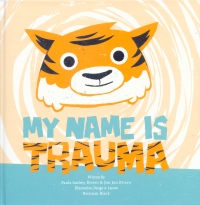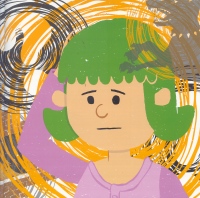| ________________
CM . . . . Volume XXI Number 8 . . . . October 24, 2014
excerpt:
My Name Is Trauma is a picture book aimed at child survivors of trauma and at children who interact with survivors. This self-published book takes the reader through facts about different elements of trauma: it can be experienced by anybody, its triggers vary from person to person, it can be overcome. Trauma is personified as a cartoon tiger. The first time authors, Paula Audrey Rivero and Jonathan Rivero are both certified trauma specialists and have significant experience working with survivors of trauma. One of the earliest audiences of the book were Filipino children who lived through typhoon Haiyan.
The written text is approachable and simple enough for a young child to follow. The concept of the tiger has a lot of potential. I can see it being a useful tool for children who have experienced trauma. They could use a tiger vocabulary to explain their feelings and behaviour to others, and they may find the mental image of an internal protective tiger a helpful way to think about difficult emotions. In addition, the book ends on a clear positive note: "you are a survivor." However, there is very little information on how to overcome the effects of trauma. I would like to see more information on this process both in the text and in an adult guidance note at the end of the book. My main criticism of the book is one of terminology. The authors use a very broad definition of "trauma". The word seems to stand for both the original traumatic event (hurricane, fire, etc.) and the ongoing effects of this event (memory issues, anxiety, etc.). This problematic usage makes it hard to understand the relationship between an original scaring experience and the sometimes confusing ongoing effects of this experience. For instance, it is not the trauma which is staying "feisty and alert" because it is trying to protect a child; it is perhaps the fight or flight response. While I understand that calling the book "My Name is The After-effects of Trauma" or "My Name is PTSD" would be clumsy, the choice to call all these effects "trauma" is misleading. The book would make more sense if it described a trauma as something which happens to an individual, and then used the tiger metaphor to describe the ongoing effects of this experience. The book would also be improved by the addition of an adult reader's guide and a further reading list for a general audience. In particular, I believe the tiger imagery is referencing an adult book called Waking The Tiger: Healing Trauma. I would recommend that adults seek out the picturebook, A Terrible Thing Happened, which contains an extensive resource list and a note to parents and caregivers with practical tips for supporting children who have witnessed violent or traumatic events. My Name Is Trauma has an obvious intended reader and pedagogical purpose. It could be a useful tool for trained teachers and therapists to explain the feelings and behaviours of survivors. It is visually appealing and offers hope to both survivors and their communities. However, due to the confusing terminology and the lack of information about how one heals trauma, I would recommend that only people who have knowledge of trauma and healing strategies use this book as a therapeutic aid. Recommended with Reservations. Lian Beveridge is an independent scholar based in Vancouver, BC. Her primary research interests are children's literature (especially picture books) and queer theory. Copyright © the Manitoba Library Association. Reproduction for personal use is permitted only if this copyright notice is maintained. Any other reproduction is prohibited without permission.
Next Review |
Table of Contents for This Issue
- October 24, 2014. |

 Brennan Black's lively and appealing computer generated illustrations are a strength of the book. The mixture of cute and dangerous in the tiger nicely encapsulates the message of the text. For instance, the illustration for the words "Life may not be easy when I am awake" is of a huge tiger clinging to the back of a person. While the tiger is made up of unthreatening round lines and soft colours, it is still obviously impeding the character. It is larger than she, and one arm is covering her eyes. The illustration portrays a past experience of trauma as something overwhelming and difficult, but not scary or undefeatable. Drawing trauma as a tiger is a good way to maintain reader interest in the somewhat dry narrative.
Brennan Black's lively and appealing computer generated illustrations are a strength of the book. The mixture of cute and dangerous in the tiger nicely encapsulates the message of the text. For instance, the illustration for the words "Life may not be easy when I am awake" is of a huge tiger clinging to the back of a person. While the tiger is made up of unthreatening round lines and soft colours, it is still obviously impeding the character. It is larger than she, and one arm is covering her eyes. The illustration portrays a past experience of trauma as something overwhelming and difficult, but not scary or undefeatable. Drawing trauma as a tiger is a good way to maintain reader interest in the somewhat dry narrative.